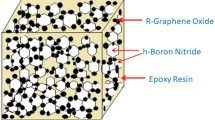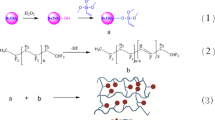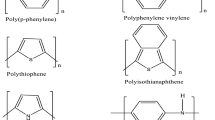Abstract
Multifunctional conductive nanocomposites based on thermoplastic polycarbonate (PC), dodecylbenzenesulphonic acid doped polyaniline (PANI-DBSA) and bismuth sulfide (BS) with good thermal and dielectric properties have been fabricated using solution casting technique. In the present work, different percentages of PANI-DBSA were blended with PC-BS composite and their electrical and dielectric properties as well as microstructural features were experimentally investigated. Analysis of positron lifetime data yielded three components, and it was observed that the increase in positron lifetime parameter viz., o-Ps lifetime at the higher concentration of PANI-DBSA, and also increase in the ortho-positronium (o-Ps) intensity at lower weight percentages of the filler may be ascribed to the increase in the interfacial space by phase separation of PANI-DBSA, BS and PC polymer matrix, and the formation of additional cavities at the interfaces of PC/BS/PANI-DBSA conducting composite, respectively. A decrease in the o-Ps intensity on the increase in filler level may be the consequence of decrease in the number of free volume holes that are available for electron—positron annihilation, due to the aggregation of PANI-DBSA. These observations are corroborated by other experimental investigations, like X-ray diffraction, electron microscopy, infrared spectroscopy, differential scanning calorimetry and thermogravimetric analysis. Further, the effect of PANI-DBSA loading in PC-BS composite on the dielectric relaxation behavior has been studied over a wide range of frequencies, from 40 Hz up to 5 MHz. The presence of two semicircular arcs in the Cole–Cole plot of the composite confirms the existence of grain and grain boundary conduction in the nanocomposite. Good AC conductivity and permittivity, together with good thermal stability makes the PC/BS/PANI-DBSA conducting composite a potential candidate for electromagnetic interference shielding and energy storage applications.
Graphical Abstract














Similar content being viewed by others
Data Availability
The datasets generated during and/or analyzed during the current study are available from the corresponding author on reasonable request.
References
A.P. Pitchiya, B.E. Slenker, A. Sreeram, C. Johnson, T. Orimolade, D. Roy, S. Krishnan, Graphene-enhanced ion transport in dual-conducting composite films of polyacetylene and an imidazolium iodide ionic liquid. Langmuir 39(19), 6767–6779 (2023). https://doi.org/10.1021/acs.langmuir.3c00259
K.A. Darwish, O.M. Hemeda, M.I. Abdel Ati, A.S. Abd El-Hameed, D. Zhou, M.A. Darwish, M.M. Salem, Synthesis, characterization, and electromagnetic properties of polypyrrole–barium hexaferrite composites for EMI shielding applications. Appl. Phys. A 129(460), 1–11 (2023). https://doi.org/10.1007/s00339-023-06738-3
J. Lin, P. Liatsis, P. Alexandridis, Flexible and stretchable electrically conductive polymer materials for physical sensing applications. Polym. Rev. 63(1), 67–126 (2023)
T. Zhu, H. Sternlicht, Y. Ha, C. Fang, D. Liu, B.H. Savitzky, X. Zhao, Y. Lu, Y. Fu, C. Ophus, C. Zhu, W. Yang, A.M. Minor, G. Liu, Formation of hierarchically ordered structures in conductive polymers to enhance the performances of lithium-ion batteries. Nat. Energy 8, 129–137 (2023). https://doi.org/10.1038/s41560-022-01176-6
M. Abutalip, G. Zhigerbayeva, D. Kanzhigitova, P. Askar, Y. Yeszhan, T.T. Pham, S. Adilov, R. Luque, N. Nuraje, Strategic synthesis of 2D and 3D conducting polymers and derived nanocomposites. Adv. Mater. 35(5), 2208864 (2023). https://doi.org/10.1002/adma.202208864
J. Hong, J. Kwon, D. Im, J. Ko, C.Y. Nam, H.G. Yang, S.H. Shin, S.M. Hong, S.S. Hwang, H.G. Yoon, A.S. Lee, Best practices for correlating electrical conductivity with broadband EMI shielding in binary filler-based conducting polymer composites. J. Chem. Eng. 455(1), 140528 (2023). https://doi.org/10.1016/j.cej.2022.140528
A.U. Rehman, A.M. Afzal, M.W. Iqbal, S.M. Wabaidur, E.A. Al-Ammar, S. Mumtaz, E.H. Choi, M. Ali, Exploring the potential of hydrothermally synthesized AgZnS@Polyaniline composites as electrode material for high-performance supercapattery device. Phys. Scr. 98(8), 085009 (2023). https://doi.org/10.1088/1402-4896/ace560
A. Nasir, A. Raza, M. Tahir, T. Yasin, M. Nadeem, B. Ahmad, Synthesis and study of polyaniline grafted graphene oxide nanohybrids. Mater. Res. Bull. 157, 112006 (2023). https://doi.org/10.1016/j.materresbull.2022.112006
S. Prashanth, M. Nagaraja, P.B. Mokshanatha, J. Pattar, S. Rajanna Manohara, K. Sunil, Structural, electrical and dielectric properties of chitosan/polyaniline/vanadium-pentoxide hybrid nanocomposites. J. Mol. Struct. 1267, 133600 (2022). https://doi.org/10.1016/j.molstruc.2022.133600
S. Rehman, A. Khan, R. Ullah, N. Anwar, L. Ali Sha, N. Shah, M. Siddique, H. Ali, Synthesis and characterization of polyaniline doped with dodecylbenzene sulfonic and oxalic acids. Russ. J. PhysChem. A 96, S87-94 (2022). https://doi.org/10.1134/S0036024422140199
M. Wang, X. Tang, J. Cai, H. Wu, J. Shen, S. Guo, Construction, mechanism and perspective of conductive polymer composites with multiple interfaces for electromagnetic interference shielding: a review. Carbon 177, 377–402 (2021). https://doi.org/10.1016/j.carbon.2021.02.047
F.A. Francis Xavier, M.D. Benoy, N.P. Ramesh, T. Varghese, Highly conducting PANI- fMWNT composites with exceptional crystallinity and enhanced thermal stability for potential applications. J. Solid State Chem. 316, 123638 (2022). https://doi.org/10.1016/j.jssc.2022.123638
A. Rayar, C.S. Naveen, H.S. Onkarappa, V.S. Betagiri, G.D. Prasanna, EMI shielding applications of PANI—ferrite nanocomposite materials: a review. Synth. Met. 295, 117338 (2023). https://doi.org/10.1016/j.synthmet.2023.117338
Anwar N, Shakoor A, Mahmood A. Synthesis and electrochemical characterization of polyaniline doped cadmium oxide (ANI-CdO) nanocomposite for supercapacitor applications. J. Energy Storage 2022;55(B):105446. https://doi.org/10.1016/j.est.2022.105446
S. Sankar, M.T. Ramesan, Studies on optical properties, thermal stability and electrical conductivity of copper alumina nanoparticles-reinforced poly(pyrrole-co-indole) for optoelectronic devices. J. Mater. Sci. Mater. Electron. 33, 21762–21777 (2022). https://doi.org/10.1007/s10854-022-08965-5
S. Sankar, A.A. Naik, T. Anilkuma, M.T. Ramesan, Characterization, conductivity studies, dielectric properties, and gas sensing performance of in situ polymerized polyindole/copper alumina nanocomposites. J. Appl. Polym. Sci. 137(38), 49145 (2020). https://doi.org/10.1002/app.49145
M.T. Ramesan, K. Nushhat, K. Parvathi, T. Anilkumat, Nickel oxide @ polyindole/phenothiazine blend nanocomposites: preparation, characterization, thermal, electrical properties and gas sensing applications. J. Mater. Sci. 30, 13719–13728 (2019). https://doi.org/10.1007/s10854-019-01753-8A
A. Furhan, M.T. Ramesan, Zinc oxide reinforced poly(para-aminophenol) nanocomposites: structural, thermal stability, conductivity and ammonia gas sensing applications. J. Macromol. Sci. A 59(10), 675–688 (2022). https://doi.org/10.1080/10601325.2022.2111262
M.T. Ramesan, P. Jayakrishnan, Role of nickel oxide nanoparticles on magnetic, thermal and temperature dependent electrical conductivity of novel poly(vinyl cinnamate) based nanocomposites: applicability of different conductivity models. InorgOrganometPolym. 27, 143–153 (2017). https://doi.org/10.1007/s10904-016-0456-x
V. Kaltenhauser, T. Rath, W. Haas, A. Torvisco, S.K. Müller, B. Friedel, B. Kunert, R. Saf, F. Hofer, G. Trimmel, Bismuth sulphide-polymer nanocomposites from a highly soluble bismuth xanthate precursor. J. Mater. Chem. C 47(1), 7825–7832 (2014). https://doi.org/10.1039/c3tc31684J
M. Chiari, M. Nippa, Y. Ikeda, T. Sato, Y. Tsujimoto, A. Kato, N. Chiba, M. Fujinami, Free volume in carbon-black-filled isoprene rubber investigated by positron annihilation lifetime spectroscopy. J. Appl. Polym. Sci. 139(36), e52857 (2022). https://doi.org/10.1002/app.52857
J. Kim, S. Kwon, D. Ihm, Synthesis and characterization of organic soluble polyaniline prepared by one-step emulsion polymerization. CurrAppl. Phys. 7(2), 205–210 (2007). https://doi.org/10.1016/j.cap.2006.05.001
Y. Haba, E. Segal, M. Narkis, G.I. Titelman, A. Siegmann, Polymerization of aniline in the presence of DBSA in aqueous dispersion. Synth. Met. 106(1), 59–66 (1991). https://doi.org/10.1016/s0379-6779(99)00100-9
S. Ding, H. Mao, W. Zhang, Fabrication of DBSA-doped polyanilinenanorods by interfacial polymerization. J. Appl. Polym. Sci. 109(5), 2842–2847 (2008). https://doi.org/10.1002/app.28355
H. Wang, J. Zhu, J. Zhu, H. Chen, Sonochemical method for the preparation of bismuth sulfide nanorods. J. PhysChem. B. 106(15), 3848–3854 (2002). https://doi.org/10.1021/jp0135003
W. Pan, S.L. Yang, G. Li, J.M. Jiang, Electrical and structural analysis of conductive polyaniline/polyacrylonitrile composites. EurPolym. J. 41(9), 2127–2133 (2005). https://doi.org/10.1016/j.eurpolymj.2005.04.003
Y. Noskov, S. Mikhaylov, P. Coddeville, J. Wojkiewicz, A. Pud, Acid-dopant effects in the formation and properties of polycarbonate-polyaniline composites. Synth. Met. 217, 266–275 (2016). https://doi.org/10.1016/j.synthmet.2016.04.015
B.S. Shashikala, M.Q.A. Al-Gunaid, T.E. Somesh, S.J. Anasuya, A. Siddaramaiah, Core-shell synergistic effect of (PANI-NaBiO2) incorporated polycarbonate films to photodegradation of MG dye and photovoltaic activity. Polym. Bull. 79, 7531–7554 (2022)
F. Tanzeela, I. Shahid, S. Mazloom, M. Qaiser, I. Bushra, M.A. Rami, S.A. Nasser, A.I. Hala, A. Shahid, Y. Muhammad, S.A. Shuja, Optoelectronic analysis of bismuth sulfide and copper-doped bismuth sulfide thin films. JOM 74(7), 2809–2816 (2022). https://doi.org/10.1007/s11837-022-05219-x
T. Abdiryim, Z. Xiao-Gang, R. Jamal, Comparative studies of solid-state synthesized polyaniline doped with inorganic acids. Mater. Chem. Phys. 90(2–3), 367–372 (2005). https://doi.org/10.1016/j.matchemphys.2004.10.036
D. Han, Y. Chu, L. Yang, Y. Liu, Z. Lv, Reversed micelle polymerization: a new route for the synthesis of DBSA-polyaniline nanoparticles. Colloids Surf. A 259(1–3), 179–187 (2005). https://doi.org/10.1016/j.colsurfa.2005.02.017
P.S. Rao, S. Subrahmanya, D.N. Sathyanarayana, Polyaniline-polycarbonate blends synthesized by two emulsion pathways. Synth. Met. 143(3), 323–330 (2004). https://doi.org/10.1016/j.synthmet.2003.12.015
C. Larosa, N. Patra, M. Salerno, L. Mikac, R.M. Meri, M. Ivanda, Preparation and characterization of polycarbonate/ multiwalled carbon nanotube nanocomposites. Beilstein J. Nanotechnol. 8, 2026–2031 (2017). https://doi.org/10.3762/bjnano.8.203
V.L. Reena, J.D. Sudha, R. Ramakrishnan, Development of electromagnetic interference shielding materials from the composite of nanostructured polyaniline-polyhydroxy iron-clay and polycarbonate. J. Appl. Polym. Sci. 128(3), 1756–1763 (2012). https://doi.org/10.1002/APP.38320
K. Dash, N.K. Hota, B.P. Sahoo, Fabrication of thermoplastic polyurethaneand polyaniline conductive blend with improvedmechanical, thermal and excellent dielectric properties: exploring the effect of ultralow-level loading of SWCNTand temperature. J. Mater. Sci. 55, 12568–12591 (2020). https://doi.org/10.1007/s10853-020-04834
P.S. Kanavi, S. Meti, R.H. Fattepur, V.B. Patil, S.M. Hunagund, S.A. Patil, S.R. Inamdar, A study on effect of MgO nanoparticles loading on the electrical conducting properties of polyvinyl alcohol/polyaniline polymer composite films. J. Nanopart. Res. 24, 232 (2022). https://doi.org/10.1007/s11051-022-05610-4
S. Habibpour, K. Zarshenas, M. Zang, M. Hamidinejad, L. Ma, C.B. Park, A. Yu, Greatly enhanced electromagnetic interference shielding effectiveness and mechanical properties of polyaniline-grafted Ti3C2Tx MXene-PVDF composites. ACS Appl. Mater. Interfaces 14(18), 21521–21534 (2022). https://doi.org/10.1021/acsami.2c03121
H. AlFannakh, S.S. Ibrahim, The AC conductivity and dielectric permittivity for PVA-treated MWCNT electrolyte composite. J. Mater. Sci. Mater. 33, 24137–24150 (2022). https://doi.org/10.1007/s10854-022-09092-x
M. Sabet, E. Mohammadian, The inclusion of graphenenanoplatelet on the mechanical, thermal, and electrical characteristics of polycarbonate. Polym. Bull. 80(2), 1–17 (2022). https://doi.org/10.1007/s00289-022-04156-8
M. Chawla, N. Shekhawat, S. Aggarwal, A. Sharma, K.G.M. Nair, Cole-cole analysis and electrical conduction mechanism of N+ implanted polycarbonate. J. Appl. Phys. 115(18), 184104 (2014). https://doi.org/10.1063/1.4876123
N. Anwar, A. Shakoor, N. Niaz, G. Ali, M. Qasim, M. Irfan, A. Mahmood, Investigation of dielectric relaxation behavior, electric modulus and AC conductivity of low doped polyaniline cadmium oxide (PANI-CdO) nanocomposites. Polym. Bull. 79, 6581–6600 (2022). https://doi.org/10.1007/s00289-021-03766-y
K. Dash, B. Nayak, B. Sahoo, Enhanced dielectric properties of the ZnO nanoparticles dispersed PU/PANI blend nanocomposites. Mater. Today 74(4), 681–687 (2022). https://doi.org/10.1016/j.matpr.2022.10.270
K. Dash, B. Sahoo, Exploring the effect of TiO2 and ionic liquid on the dielectric properties of polyurethane and polyaniline blend nanocomposites. Polym. Int. 71(7), 847–855 (2022). https://doi.org/10.1002/pi.6355
M.F. Elmahaishi, R.S. Azis, I. Ismail, F.D. Muhammad, A review on electromagnetic microwave absorption properties: their materials and performance. J. Mater. Res. Technol. 20, 2188–2220 (2022). https://doi.org/10.1016/j.jmrt.2022.07.140
N.P. Yadav, B.B. Sahu, T. Yadav, R. Kumar, A. Pathak, G.N. Pandey, S. Moharana, Enhanced dielectric and electrical properties of polystyrene-2% divinylbenzene (PDB) embedded in SrTiO3-poly (vinylidene fluoride) three-phase composite films. Optik 270, 170001 (2022). https://doi.org/10.1016/j.ijleo.2022.170001
A. Bibi, A. Shakoor, N. Niaz, Polyaniline-calcium titanateperovskite hybrid composites: structural, morphological, dielectric and electric modulus analysis. Polym. Compos. 30, 1–13 (2022). https://doi.org/10.1177/09673911221102287
E.A. Arrasheed, O.M. Hemeda, Y.A. Alibwaini, T.M. Meaz, R.M. Shalaby, A. Ajlouni, A.M.A. Henaish, B.I. Salem, Dielectric, electrical, magnetic, and mechanical properties of Ni-Al ferrite/PANI composite films. Ph. Transit. 95(11), 803–822 (2022). https://doi.org/10.1080/01411594.2022.2117043
K. Dutta, S.K. De, Electrical conductivity and dielectric properties of SiO2 nanoparticles dispersed in conducting polymer matrix. J. Nanopart. Res. 9, 631–638 (2007). https://doi.org/10.1007/s11051-006-9184-4
S. Ningaraju, A.P. Gnana Prakash, H.B. Ravikumar, Studies on free volume controlled electrical properties of PVA/NiO and PVA/TiO2 polymer nanocomposites. Solid State Ion. 320, 132–147 (2018). https://doi.org/10.1016/j.ssi.2018.03.006
L. Yang, X. Liu, Z. Lu, T. Song, Z. Yang, J. Xu, W. Zhou, X. Cao, R. Yu, Q. Wang, Free volume dependence of the dielectric constant of poly(vinylidene fluoride) nanocomposite films. RSC Adv. 12(38), 24734–24742 (2022). https://doi.org/10.1039/D2RA04480C
R. Ramani, G. Shariff, M.C. Thimmegowda, P.M. Sathyanarayana, M.B. Ashalatha, A. Balraj, C. Ranganathaiah, Influence of gamma irradiation on the formation of methanol induced micro-cracks in polycarbonate. J. Mater. Sci. 38, 1431–1438 (2003). https://doi.org/10.1023/A:1022951926769
R. Mirji, B. Lobo, D. Dutta, S.P. Masti, M.P. Eelager, Experimental investigation of the structural features of polycarbonate (PC) filled with bismuth nitrate pentahydrate (BNP) composite films in terms of free volume defects probed by positron annihilation lifetime spectroscopy. Appl. Radiat. Isot. 196, 110773 (2023). https://doi.org/10.1016/j.apradiso.2023.110773
S. Ningaraju, V.N. Hegde, A.P. Gnana Prakash, H.B. Ravikuma, Free volume dependence on electrical properties of poly (styrene co-acrylonitrile)/nickel oxide polymer nanocomposites. ChemPhysLett 698, 24–35 (2018). https://doi.org/10.1016/j.cplett.2018.03.002
P. Utpalla, S.K. Sharma, J. Prakash, J. Bahadur, M. Sahu, P.K. Pujari, Free volume structure at interphase region of poly (ethylene oxide)-Al2O3nanorods composites based solid polymer electrolyte and its direct correlation with Li ion conductivity. Solid State Ion. 375, 115840 (2022). https://doi.org/10.1016/j.ssi.2021.115840
S. Ningaraju, H.B. Ravikumar, Studies on electrical conductivity of PVA/graphite oxide nanocomposites: a free volume approach. J. Polym. Res. 24(11), 1–11 (2017). https://doi.org/10.1007/s10965-016-1176-1
Acknowledgements
The authors would like to thank Manipal Institute of Technology, Manipal for providing the XRD scans of the sample. The authors thank USIC, Mangalore University, Mangalore for providing an ATR-FTIR facility to scan the samples. The authors would like to thank the Indian Institute of Technology, Kanpur for providing the facility to scan SEM images of samples. PALS measurements were performed using the facility at the Saha Institute of Nuclear Physics, Kolkatta, India.
Funding
No funding was received for conducting this study.
Author information
Authors and Affiliations
Contributions
SM and MA have made substantial contributions to the conception and acquisition of experimental data. PMGN has involved in the analysis and interpretation of data. RM has participated in determining the experimental results, designing, analyzing data and drafting the manuscript. BL has corrected the paper and given final approval for the version to be published. All authors read and approved the final version of the manuscript.
Corresponding author
Ethics declarations
Conflict of interest
The authors declare that they have no conflict of interest.
Additional information
Publisher's Note
Springer Nature remains neutral with regard to jurisdictional claims in published maps and institutional affiliations.
Rights and permissions
Springer Nature or its licensor (e.g. a society or other partner) holds exclusive rights to this article under a publishing agreement with the author(s) or other rightsholder(s); author self-archiving of the accepted manuscript version of this article is solely governed by the terms of such publishing agreement and applicable law.
About this article
Cite this article
Mirji, R., Lobo, B., Mukherjee, S. et al. Influence of Polyaniline as Filler on the Microstructural Features and Properties of Polycarbonate: Bismuth Sulfide Nanocomposite. J Inorg Organomet Polym 34, 1232–1255 (2024). https://doi.org/10.1007/s10904-023-02886-4
Received:
Accepted:
Published:
Issue Date:
DOI: https://doi.org/10.1007/s10904-023-02886-4




